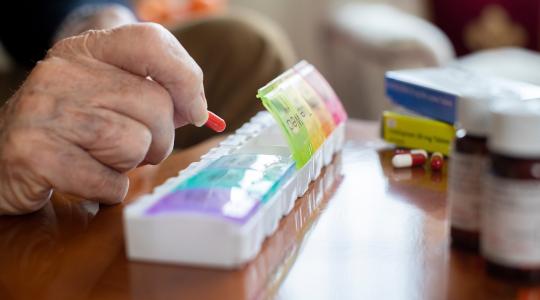Osteoporosis is a disease that occurs when the body loses too much bone density, increasing the risk of a fracture (broken bone). Half of women and a quarter of men over age 50 will break a bone during their lifetime because of osteoporosis.
But by partnering with your healthcare provider, you can take charge of your bone health and help prevent fractures. Talk with your provider about osteoporosis testing. Testing provides information about your bone density and strength. With this information, you and your provider can work together to prevent bone loss and fractures.
What is osteoporosis?
Throughout your life, your body is constantly making new bone and removing old bone tissue. This renewal process keeps bones strong. But when you have osteoporosis, the body can’t make new bone quickly enough. As a result, the bones lose more tissue than they gain. Over time, bones lose some of their structure and strength.
Osteoporosis can affect men and women of any age, but it’s more common among people over age 65. As we age, the body’s bone renewal process slows down. Other risk factors include:
- Slender or thin build: People who have thinner or smaller bones tend to have less bone mass.
- Race: Non-Hispanic white women, women of Asian descent and white men have a higher risk than other ethnicities.
- Family history: If your parent had osteoporosis or a hip fracture, you have a higher risk.
- Hormone levels: Low estrogen in women and low testosterone in men may increase the risk of osteoporosis.
- Smoking: Smoking causes decreased bone mass. If you smoke, check with your insurance company about smoking cessation resources. You can also ask your doctor for help.
- Alcohol: Drinking high amounts of alcohol raises the risk of osteoporosis. Limit alcoholic drinks to two drinks per day for men and one drink per day for women.
Getting tested for osteoporosis
Osteoporosis is called a “silent disease” because it usually has no symptoms. Many people don’t know they have osteoporosis until they break a bone. That’s why osteoporosis testing is important. If osteoporosis is caught early, treatment can help prevent further bone loss and future fractures.
What is a bone density test?
Your bone density is the amount of mineral in your bones. A bone mineral density test, also called a bone density test, measures your bones’ strength and thickness. It can spot osteoporosis before a bone fracture occurs.
A bone density test can also diagnose osteopenia, which is a low bone density condition. If you have osteopenia, it means you have a higher risk of getting osteoporosis in the future.
What happens during a bone density test?
A bone density test is safe and painless. It uses a special kind of X-ray to look at the inside of the bones. The amount of radiation in a bone density test is less than in a standard chest X-ray.
To prepare for the test:
- Avoid calcium supplements for 24 hours before the test.
- Don’t wear metal jewelry or clothes with metal parts on the day of the test.
What to expect during a bone density test:
- You can usually wear your regular clothes.
- You lie still on a padded table while a scanner passes over your body.
- The scan takes about 20 minutes.
- After the test, you can go home.
Your provider gets the results and discusses what they mean for your bone health. Ask your provider when you should expect the results.
If your results show you have low bone density, your provider may recommend steps to prevent bone loss and fractures, including:
- Moving more, such as walking, dancing and lifting weights
- Getting enough calcium and vitamin D from foods or supplements
- Taking prescription medicines that increase bone density
- Using fall prevention strategies, such as removing area rugs and wearing proper shoes
When to get tested for osteoporosis
Talk to your provider about when you should get a bone density test. Most low-risk women should get tested by age 65 and men by age 70.
But people who have risk factors for osteoporosis may need a test sooner. Risk factors include a family history of osteoporosis, certain health conditions or low calcium intake.
Discuss your risk factors with your provider. Together, you can decide when you should get a bone density test.
Enhancing patient experience by partnering with your provider
By partnering with your care provider, you can gain a better understanding of prevention methods and ways to improve your bone health. See your provider regularly and discuss when you should get tested for osteoporosis. Together, you can create an effective care plan that meets both your needs and goals for a better health outcome.
Sources: International Osteoporosis Foundation, Medline Plus, National Institute on Aging, National Institutes of Health, National Osteoporosis Foundation



